Vol1 No27
Table of Contents
Assist Feeding – Upper Respiratory Infection
Feline Nutrition – “Just Some Stuff”
Pro-Active Cat Care – Doing Our Best
Feline Obesity – New Series: FHL
Kitty Potpourri – Breed Profile: The Siamese!
Assist Feeding – Upper Respiratory Infection
by Kathy Fatheree
I had cats for many years before I knew that cats could really catch colds. Then came Nicholas. I adopted him at the Humane Society. he was so docile and calm for a 10-month-old kitten. that should have been a clue! For the next week he barely moved . he slept on his yellow blankie all day and all night . 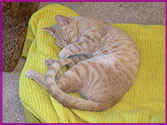 except when he was sneezing that is. The vet gave me antibiotics, and being concerned about giving antibiotics for something viral, I called the clinic and asked, “Why are you giving me antibiotics for a viral infection?” The technician was a jewel and took her time to explain about the kitty cold. The reason for the antibiotic is that the kitty cold can easily turn into pneumonia, especially in a kitten who hasn’t built a strong immune system.
except when he was sneezing that is. The vet gave me antibiotics, and being concerned about giving antibiotics for something viral, I called the clinic and asked, “Why are you giving me antibiotics for a viral infection?” The technician was a jewel and took her time to explain about the kitty cold. The reason for the antibiotic is that the kitty cold can easily turn into pneumonia, especially in a kitten who hasn’t built a strong immune system.
Nicholas had the following symptoms:
- Fever
- Lethargy
- Wet sneezes
Are you wondering why I’m writing about the Feline Cold in the Assist Feeding column? Well, let’s take a look at these symptoms and what can happen.
Fever – kitties with a fever often do not feel like eating. Nicholas ate very little. in fact he at less than my 4-year-old cats. Fever can also cause dehydration.
Lethargy – all Nicholas did the first week was get up to sneeze, eat a little, and go to the litter box. then back to sleep on his yellow blankie. He didn’t play and ate only enough to sustain him.
Wet sneezes – I found dried sneeze spots for a month after Nicholas got well. that tells you how much he was sneezing! That much sneeze material can lead to dehydration.
Think about these symptoms. if he wasn’t eating much, not drinking much, had a high fever. what could this lead to? That’s right. dehydration. Also, with the wet sneezes, his nose was all clogged up. he could barely breath. much less smell his food. that could lead to malnutrition.
When very young kittens and older cats come down with a cold, they often stop eating altogether. I was lucky with Nicholas. It is very important to get the symptoms under control. especially important to unclog that nose so that they can smell and eat their food so that they can get well again.
Here are some tips to help a cat with a cold:
- For thick mucus in the nose, buy a warm air humidifier and do several sessions thoughout the day, if possible, to help break up the mucus. I’ve heard of people running a hot shower with kitty in the bathroom, but unless your cat is accustomed to this experience, it’s best not to stress him or her out. The less mucus in the nose. the easier to smell the food.
- Buy foods that are really smelly. the smellier the better. If your cat is not accustomed to eating canned food, mix a little canned food in with the dry.
- If you feed dry food, wet it with water or broth from boiled chicken (NOT store bought broth because it may contain onion, MSG, or other unlabeled impurities). Wetting the food will make the food more aromatic and will help hydrate your cat.
- Warm the food slightly to make the food more aromatic. I like to warm the food by placing a dish of food within a bowl of hot water. Stir the food until the desired temperature is reached. Place a little of the warmed food on the inside of your wrist to make sure that it is not too hot. Food warms up fast with this method so be careful.
- When feeding, present small portions. You know how when you feel sick and tons of food is placed in front on you? Best to feed small portions and many meals throughout the day.
- Keep in close contact with your vet and watch for fever and dehydration in kitty. Your vet may need to prescribe fluid therapy (subQ fluids) if your cat becomes dehydrated.
- Ask your vet if antibiotics would be helpful to prevent pneumonia from setting in. With Nicholas’ symptoms. it was very important!
- If your cat stops eating for even a day, you will need to assist feed by either placing food in your cat’s mouth with your finger, putting food on kitty’s paw in hopes that kitty will lick it off, or by syringe feeding.
Nicholas was really, really sick for a week… and his sneezing stopped at Day 12. It was a tough haul for that little boy, but we made it!
Feline Nutrition – “Just Some Stuff”
by Garry White
I’ve noticed something with Clarkie that’s a bit troubling, and I thought you folks might have some input. You may recall that I’m trying to mix up his diet (some canned, some dry), and I’ve noticed over the past several months that whenever I feed him TUNA, he’ll vomit a few times several hours later, or the next day. It doesn’t seem to have a lasting affect, or a damaging one, because he’s back at the dry-food bowl a few minutes later, he plays, he’s active, blah-blah. But it sure isn’t right, and I’m pretty well convinced that the “link” is the tuna, and any brand seems to have the same effect. I’m going to confirm this soon with another “test”, and then I’m going after it with gusto! Wanna help me untangle this one? If so, meet me at the forum.
I have to compliment Kathy on her outlook about Phoebe’s diet and her approach to managing it. Right or wrong, the logic is sound that if a food is supplying all of the proper nutrition, in the right quantities, they won’t eat as much of it because the body’s systems are “satisfied” more easily. I’ve long felt that cats (and us too, for that matter) will eat more of something to get a specific element that may be deficient in that food.
It’s all in the details: Yep, I bug you folks routinely to pay closer attention to the nutritional details of Kitty’s food, but I do it with a good heart, and here’s a classic example of why it’s so important: We’ll play with just one element (Potassium) and see how drastic the differences can be. Potassium is a necessary nutrient, but only in the proper quantities. Too little can cause a variety of problems, and too much can cause heart failure. I used our handy-dandy Nutrition Calculator, and ran the numbers on two foods. Food-A was 81.41% moisture, with a potassium level of 0.91%. Food-B was 74.07% moisture with potassium at 0.33%. When I took out the water (converted to dry-weight), here’s what we have:
Food-A: 4.90% (1.548 grams!) of potassium
Food-B: 1.27% (.0561 grams) of potassium
That’s a difference of about three hundred percent, folks! Now do you see why those tiny details are so important?
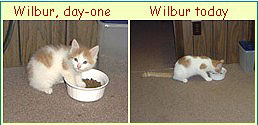
Cat Trivia: What is the tapetum lucidium, and where is it found on a kitty?
ProActive Cat Care – Doing Our Best
by Garry White
Not long ago, a friend (we’ll call him John) and I were discussing what he called the vagaries of pet ownership, and after we got the “ownership” issue squared away, it turned into an interesting confab. John has a very small dog of some kind (his first pet since childhood, by the way), which became.well, let’s just say not constipated. In fact, let’s say very not constipated, okay? Knowing what I went through with Lewie, and of my continued involvement with pets and pet issues, I got tapped with: “What should I do?” I offered some advice which apparently worked, and which helped to escalate my lofty position of local pet guru. I suppose my rates (ZIP!) have a lot to do with my fame, though. Especially since my first offering is always the same: “See a vet.”
Anyway, John and I are getting pretty deep into pet care, and he says: “You know, I had no idea it would be this much work! I mean, think about it: You got the food issues of what he’ll eat and what he won’t, fleas, nasty little ear bugs, stuff he ruins around the house, having to take him for walks. It’s like you have to shut your whole life down in order to focus on what this pet needs!”
I thought about this for a minute before responding: “You forgot to include dealing with sicknesses, the cost of medications and vet care, special bedding, grooming, watching their behavior, taking cautionary measures with household plants and toxins, and dealing with their personality. You also forgot to mention how much love he gives you in return for these menial chores, and you forgot to mention that that tiny dog probably didn’t barge his way into your house and scream.‘I’m here and I’m staying, by God!‘ ” But it got me to thinking, you know? To a non-pet-person, these caregiver tasks probably are significant; a burden. But to us pet-folks it’s merely part of our daily life. We don’t stand vigilant watch over the litterbox for days on end, but we do keep an eye on things. We don’t have a laboratory analysis done on their foods, but we do spend a little effort sorting out the bad from the good. We don’t race them off to the vet if their mood changes for a day, but we do learn to watch for signs of problems. In short, we live a life that includes a pet, and we do what we can to keep the whole kaboodle in balance. I guess the conversation with John made me realize something: Sure we’re cognizant of a pet’s existence, because they need us, and we do things we wouldn’t have to do if there was no pet. But they don’t rule our lives; they enhance our lives! No, I cannot simply drive off for a week without advance preparation, but neither could I do so if I had a child, a spouse or mate, a fish, bird, or any other living organism in residence with a pulse stronger than the couch. Yes, I’ve spent plenty of sleepless nights with a sick pet, but so have I with sick kids and sick wives. As for the “tasks” of managing a pet, we don’t even think about it. We don’t “shut our lives down”, as John suggested. We just make those little things part of our routine, and.we do the best we can.
they enhance our lives! No, I cannot simply drive off for a week without advance preparation, but neither could I do so if I had a child, a spouse or mate, a fish, bird, or any other living organism in residence with a pulse stronger than the couch. Yes, I’ve spent plenty of sleepless nights with a sick pet, but so have I with sick kids and sick wives. As for the “tasks” of managing a pet, we don’t even think about it. We don’t “shut our lives down”, as John suggested. We just make those little things part of our routine, and.we do the best we can.
Feline Obesity – New Series: FHL
by Kathy Fatheree
This past week, Phoebe gave me a scare. She has been eating her new food just fine and then one day she stopped eating half way through her meal and walked away. She often leaves a little in the bowl, but not half of the serving! The first thought that went through my head was ohmygosh. she is going to get FHL (Feline Hepatic Lipidosis). Fat Cats who suddenly stop eating are at high risk for developing this treatable but sometimes fatal liver disease.
Several years ago, I had a cat die of complications from surgery for a liver biopsy and tube implantation to treat FHL and I’ve never gotten over that. That kitty, Isky, is one of the reasons I started the www.AssistFeed.com website and this Newsletter. There are things that both my vet and I could have done to easily prevent his death. It was a such a waste. Isky’s other name was Tater – as in sack of potatoes. My brother could drape him over his head… kitty legs dangling by his ears and he could walk around the house that way… Isky loving every minute of it. He loved to lay in my brother’s arms while laying on the couch. belly up… watching TV. Too cute. such a wonderful creature.
Anyway. back to Phoebe not eating. I sat down with her and fed her the rest of her food one piece at a time. I did this any time she didn’t eat most of her food. As it turns out, she is just fine. I think that she is not eating as much of her new food because it is not a diet food. It has all the great fat, protein and nutrients that a good holistic food should have. She’s just eating a little less than normal now and she is happy as a clam.
Because of this little scare, I think it’s time to launch a Newsletter series about Feline Hepatic Lipidosis so that we can all learn the specifics of this disease. We are going to cover everything from what this disease is, what happens to the kitty, treatment options and most importantly. how to prevent it!
Kitty Potpourri – Breed Profile: The Siamese!
by Dan Malenski
This week we will be talking about the Siamese breed and tell you something about their physical characteristics and temperament. Again, we were faced with the quandary of having to decide about which fabulous breed to talk about… but were saved from having to engage in another one of our heated debates by a special request to talk about… the Siamese!
The Siamese has a slender body with long, slim legs 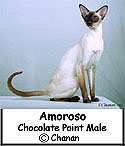 and a long tail tapering to a fine point. The paws are small and oval shaped with five toes on the front and four behind. The head is long, wedge shaped, and the ears are large. The coat is very short and fine textured, which tends to emphasize these characteristics very well.
and a long tail tapering to a fine point. The paws are small and oval shaped with five toes on the front and four behind. The head is long, wedge shaped, and the ears are large. The coat is very short and fine textured, which tends to emphasize these characteristics very well.
The size of the cat is average, with the males attaining a weight of 11-15 pounds and the females 8-12. The eyes are of a bright or dark blue, almond shaped, and have the ability to captivate those who gaze into them.
The Siamese comes in the following colors:
- Seal point: pale fawn to cream body, gradually turning lighter on the stomach and chest; the points are seal brown. Nose leather and paw pads are the same color as the points.
- Chocolate point: the body is a solid ivory and the points resemble the color of milk chocolate. The nose leather and paw pads are medium brown-pink.
- Blue point: the body is bluish white, gradually turning to white on the stomach and chest; the points are deep blue. The nose leather and paw pads are the color of slate.
- Lilac point: the body is solid white and the points are frosty grey with a pinkish tinge. The nose leather and paw pads are lavender-pink.
The eyes are a deep blue regardless of body coloring.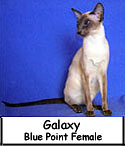 Amanda interrupted me at this time and asked, “I’m a tabby, and I understand tabby but what’s a point?” Well, that’s a good question! When referring to Siamese coloring, points refer to different parts of the cat’s body, that is, their face, ears, legs, paws, and tail.
Amanda interrupted me at this time and asked, “I’m a tabby, and I understand tabby but what’s a point?” Well, that’s a good question! When referring to Siamese coloring, points refer to different parts of the cat’s body, that is, their face, ears, legs, paws, and tail.
The Siamese cats are excellent companions and lap warmers with a mellow temperament and are very intelligent, but the latter doesn’t necessarily mean that they are easy to train. Remember that they are still cats and possess their own unique personalities. Their most outstanding trait could be the volume of their voice, as they could be extremely loud. Their “Meow” cannot be classified as a polite request by no means, but definitely a non-negotiable demand! The characteristics of their voice stem from kittenhood, so you will not have to wait long in order to find out.
If you feel that you must now have a Siamese, they are available from many breeders, but be certain that you adopt one from a professional breeder, not one who just assumes the title. Most professional breeders will very carefully screen you and may go as far as making you sign a contract prior to releasing any kitten or cat to you. Some of these requirements may be that you will keep the cat indoors, will not declaw, and many others. A better method is to visit http://www.petfinder.org, fill in the appropriate fields including your zip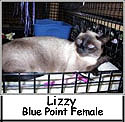 code, and be shocked to find that hundreds may be available for adoption right in your own back yard! Typing in my zip code yielded 296 results! While most are Siamese mixes, dozens of pedigreed cats were available for adoption. Finally, all would make loving companions. The photo (Lizzy) in this paragraph is just one that I copied from one of the many results I got from the petfinder web site. She appears to be a blue point Siamese who is just gorgeous! The proper domain for her is a cat show-not an animal shelter!
code, and be shocked to find that hundreds may be available for adoption right in your own back yard! Typing in my zip code yielded 296 results! While most are Siamese mixes, dozens of pedigreed cats were available for adoption. Finally, all would make loving companions. The photo (Lizzy) in this paragraph is just one that I copied from one of the many results I got from the petfinder web site. She appears to be a blue point Siamese who is just gorgeous! The proper domain for her is a cat show-not an animal shelter!
Disclaimer: Kathy Fatheree is not at all a medical expert. Contents of this web site are a collection of Kathy’s assist feeding experiences as well as the experiences of other cat owners who have assist fed their cats. While every effort has been made to ensure the accuracy of the information, Kathy Fatheree or anyone associated with this web site cannot be held responsible for anything that may happen as a result of using the information on this site.
